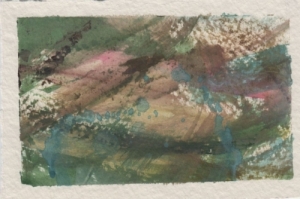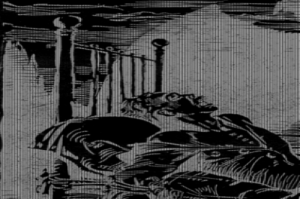
St. Paul’s Anglican Church. Photo by Iota 9 Source: Wikimedia Commons.
It’s Palm Sunday, and I’m standing in Nelson Park with parishioners from St. Paul’s Anglican Church, waiting to proceed to the church on Jervis Street two blocks away.
There’s a trumpeter, a trombonist, a few drummers and choir members in robes. A few people hand out palm leaves. After the priest, Markus Dünzkofer, tells us how we will proceed, he adds, “If bystanders ask what we’re doing, refer them to Clare, our seminarian.”
Everybody laughs. Clare looks uneasy.
As people begin to sing “All Glory, Laud, and Honour,” I get the image of a Salvation Army band, and offer a silent prayer that I see no one I know along the way.
I am here, after all, as a journalist, not a churchgoer.
Once inside the church, after the Opening Versicle, the Hosannas, hymns, prayers, the Gospel, and Confession and Absolution comes the Peace, during which we all turn and nod to one another, or shake hands briefly and say: “Peace be with you.”
I know the drill.
But what’s this? It goes on and on. People wander up and down the centre aisle, in and out of the pews, embracing one another and greeting more and more people.
I think: Good Lord, we’ll be here until Tuesday! Let’s get on with it.
The truth is I’m uncomfortable. All of this flies in the face of what I’d come to view as the stuffiness of the Anglican Church. Not that I like stuffiness. It’s just that all this kissing and hugging throws me off balance.
The truth is these people seem to know and care about each other in a way I don’t normally associate with church.
My reaction surprises me. Even more surprising is that I return for Good Friday services and again for Easter Vigil.
“The Anglican Church isn’t the church of your grandmother and grandfather,” Markus Dünzkofer tells me in a phone interview many weeks later.
Apparently, it’s also no longer the Church of the Empire, or the last bastion of British immigrants in Canada, an image that many Anglicans have been trying to change for years now. And Dünzkofer, a German who studied theology in Edinburgh and was ordained in Chicago, is emblematic of that change.
Curiosity and openness
“We’re an ever-changing community,” Dünzkofer explains, “a crazy and wonderful community. There’s an openness at St. Paul’s, a real curiosity about people, a willingness to engage with the divine, with each other and the neighborhood.”
The young woman to whom Markus Dünzkofer wanted to refer questions during the procession on Palm Sunday is seminarian Clare Morgan, aged 27, a self-proclaimed “Christian punk Goth.”
“I’m like normal here, not anybody’s mascot,” she says. “I still consider myself part of the Cathedral, but you come in with tattoos and a weird haircut and people love you, but they’re a little titillated to know someone like you. I never noticed until I was at St. Paul’s that no one here made assumptions. People don’t kind of slot you into something like: Oh look! A young person with blue hair!”
“We may look as if we’re all WASPS,” says parishioner Leslie Buck, “but you look a bit deeper, and there’s an impressive diversity: Dutch, German, French, Turkish, Iranian, Japanese, Korean, Russian, Spanish.”
Ordination of women and same-sex marriage
A British-born, life-long Anglican, Buck came to St. Paul’s in 1993 when he and his wife moved here from Ottawa.
“We do things now that would have appalled people 50 years ago,” says Buck citing the ordination of women and same-sex marriage. He also cites shifts in the teaching.
“There was a time when the message was primarily keep your nose clean and don’t worry too much about what you do at work the rest of the week. Nowadays more is made of the social gospel, issues like homelessness and poverty. Which is not to say that one’s individual relationship with God or one’s behavior is not an issue, but the church is also responding to the world.”
Buck gives me a bit of St. Paul’s history. The church was first formed in Yaletown, and parishioners included Canadian Pacific Railway workers and their families.
As people prospered, they moved to the West End to build mansions. In fact, a friend of mine insists it was Benjamin Tingley Rogers (of BC Sugar fame) who started the trend in 1900 by building his massive stone house on the corner of Davie and Nicola. And when Mr. and Mrs. Rogers moved on to Shaughnessy, the socially ambitious followed suit, which in turn marked the beginning of what the West End has become today—primarily apartments and condos for single people, small families, and pensioners.
The present St. Paul’s was built in 1905, at a time when the West End was still home to Vancouver’s prosperous.
“The original ethos and style remained much the same from 1905 until 1985 when last of the old style rectors retired. David Crawley took his place and started to change things. The church started ministering to AIDS patients. The change came from the rector, but gradually everyone became supportive and more gay people came into the church, which changed the make-up of the congregation.”
Change or close
“After World War II and up to the eighties,” says Dünzkofer, “the parish thought of themselves as the bastion of English. David Crawley gave them a choice: change or close.
He flung the doors open, and people came in: prostitutes and drag queens. It’s heartbreaking reading the records in the mid 80s. There were three or four funerals a week during the AIDS pandemic. People came to think of us as the gay church. I would not use that term. We are the West End church. We reflect the particular make-up of the neighborhood. We put energy into the questions of poverty in the neighborhood, and what it means to be a Christian with social conscience, and how to be a traditional Christian community that’s open to welcome people in, without losing identity.”
“I think the easiest answer is worship,” Dünzkofer continues. “It’s the centre of who we are. I still think it opens ways into the mysteriousness of God—that constant rhythm of prayer. It empowers us to do the work we’ve been given to do. We are very much a praying community.“
In 1995, St. Paul’s established its Advocacy Office to provide information and support to anyone in the community who sought help with housing problems, legal problems, immigration issues, welfare applications, and other access to government services. The office used to see around 1,000 clients a year. Now it’s over 3,000.
St. Paul’s also supports Our House, a recovery house for people trying to break free of addiction to drugs and alcohol.
“We have a grant for a full-time homeless outreach worker,” says Dünzkofer. “The neighborhood puts a high demand on the church. Other parishes have more advocacy resources. We need to be creative in finding more resources for that.”
Some in the community know St. Paul’s because it’s where their chorus meets, or their regular 12-step meeting is. Others know it because it’s church hall houses a labyrinth that one can walk as a meditation.
“The labyrinth program was first established by people in the church,” says Leslie Buck, “but it opened itself up to the community in general, so we find people coming there who have very little to do with the church. Some wouldn’t be caught dead in the church.”
When I ask about St. Paul’s future, everyone seems to point to the past. In other words, they feel they can lean into the reconciliatory history of the Anglican Church, and its stand for freedom of thought and expression.
“The saint of the Anglican Church was Elizabeth I,” says Buck. “She established the importance of common prayer over a confession of faith. And that has persisted. We’re more open to individual interpretation, to the spirit rather than the letter of the law.”
Buck is optimistic about St. Paul’s future.
“My optimism lies in the current situation, on the people who are here and the way in which they go about their business. “In general people here are of good will. The Spirit is among us. If we keep our wits about us and don’t get complacent, I have hope for the future, though I have no idea what it will be.”
Seminarian Clare Morgan says, “I still hold out for a church where we try as hard as we can to stay together as a family, with a commitment to talking and sharing stories. A lot of fundamentalists go and split and form another church and keep splitting. A friend of mine likes to say ‘We’re good at being heretics, but we don’t like to be schismatic.’ So we yell at each other, but we’re all still Anglican.”
A deepening identity, advocacy and community
From Dünzkofer’s point of view, St. Paul’s future includes a deepening sense of identity. “I crave tradition that creates mystery,” he says, “that sense of the numinous. We also want to experience liturgy that meets people where they are. Some conversation needs to happen [about this], and we have great resources to deal with that. It is our tradition—the language of the people—and worship is a common experience. Praying together—that’s how we find out what God is telling us to do.”
St. Paul’s has faced many changes in the past 27 years. And now it faces yet another. At the end of Sunday’s service on October 21, one of the Church Wardens stepped forward to announce that Markus Dünzkofer has been called to be the next rector of St John’s Episcopal Church in Edinburgh, and he has accepted. He will be leaving St. Paul’s at the end of December.
Dünzkofer says what impressed him most about St. Paul’s when he arrived eight-and-a-half years ago was “the intentionality of ministry in this community—in worship and music and the labyrinth. They were intentional about building it and intentional about getting the community involved. It’s the same thing with advocacy.”
One senses that this same intentionality along with discerning prayer and dialogue will be what carries St. Paul’s through its next set of changes.


